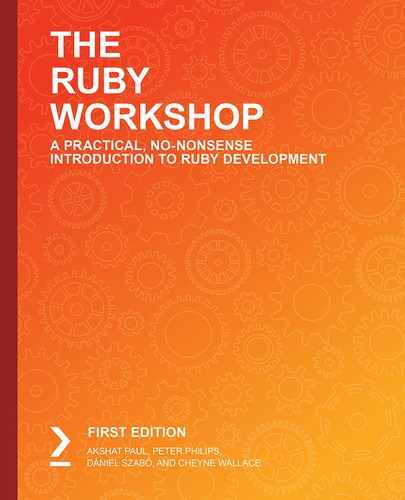The Ruby Workshop
A Practical, No-Nonsense Introduction to Ruby Development
Akshat Paul
Peter Philips
Dániel Szabó
Cheyne Wallace
The Ruby Workshop
Copyright © 2019 Packt Publishing
All rights reserved. No part of this book may be reproduced, stored in a retrieval system, or transmitted in any form or by any means, without the prior written permission of the publisher, except in the case of brief quotations embedded in critical articles or reviews.
Every effort has been made in the preparation of this book to ensure the accuracy of the information presented. However, the information contained in this book is sold without warranty, either express or implied. Neither the authors, nor Packt Publishing, and its dealers and distributors will be held liable for any damages caused or alleged to be caused directly or indirectly by this book.
Packt Publishing has endeavored to provide trademark information about all of the companies and products mentioned in this book by the appropriate use of capitals. However, Packt Publishing cannot guarantee the accuracy of this information.
Authors: Akshat Paul, Peter Philips, Dániel Szabó, and Cheyne Wallace
Technical Reviewers: Jonathan Evans, Jagdish Narayandasani, and Dixitkumar N. Patel
Managing Editor: Snehal Tambe
Acquisitions Editor: Alicia Wooding
Production Editor: Samita Warang
Editorial Board: Shubhopriya Banerjee, Bharat Botle, Ewan Buckingham, Megan Carlisle, Mahesh Dhyani, Manasa Kumar, Alex Mazonowicz, Bridget Neale, Dominic Pereira, Shiny Poojary, Abhishek Rane, Erol Staveley, Ankita Thakur, Nitesh Thakur, and Jonathan Wray
First Published: October 2019
Production Reference: 1301019
ISBN: 978-1-83864-236-5
Published by Packt Publishing Ltd.
Livery Place, 35 Livery Street
Birmingham B3 2PB, UK
